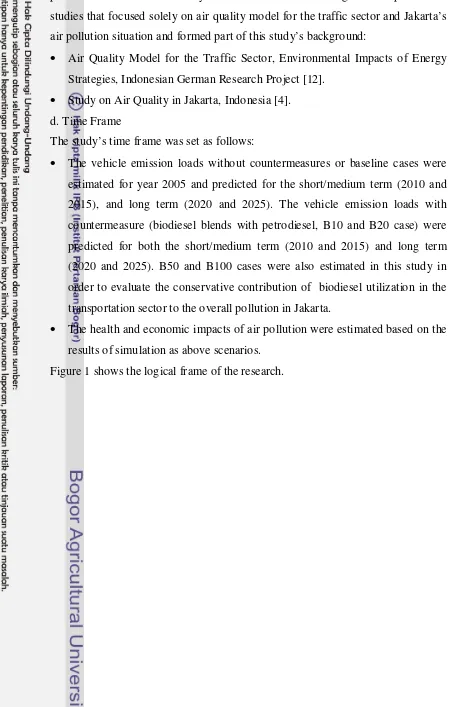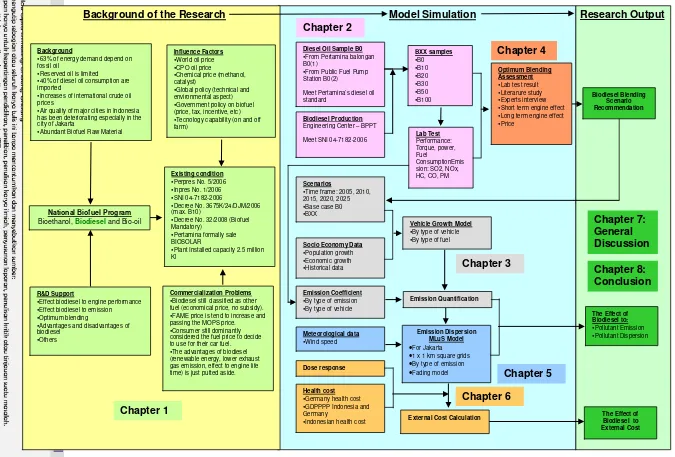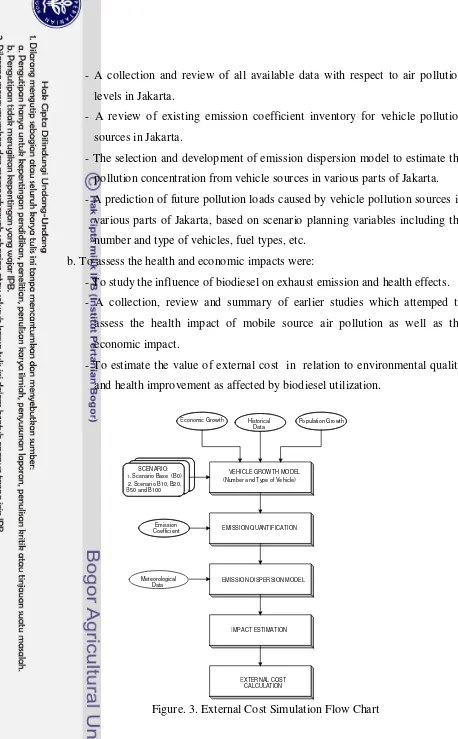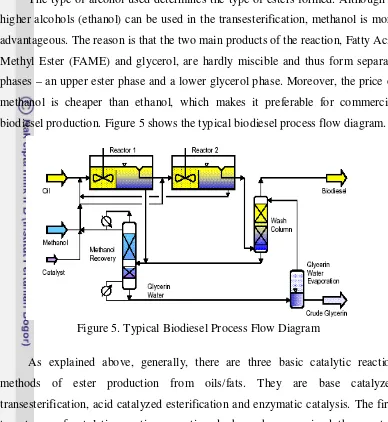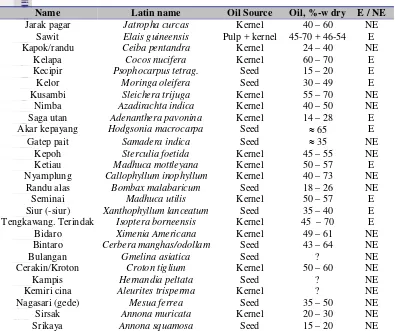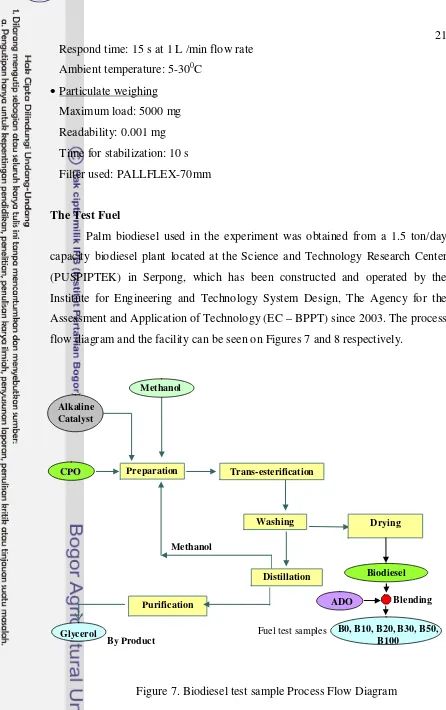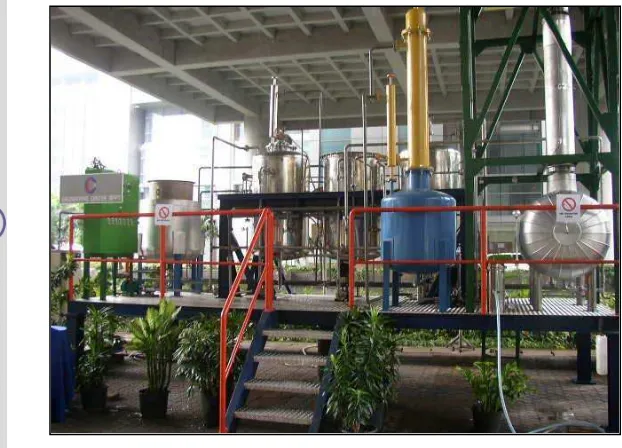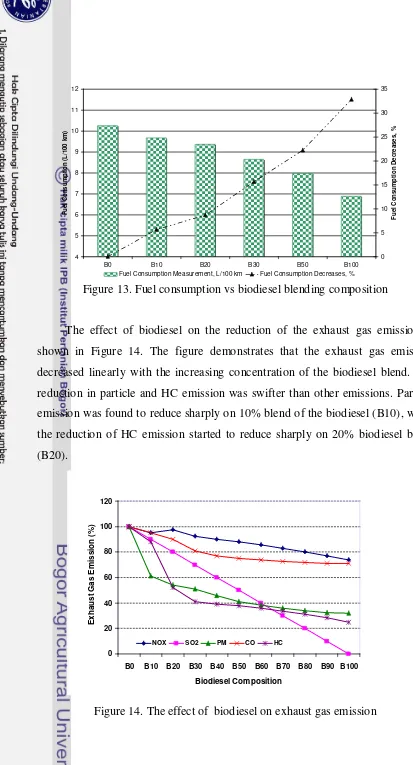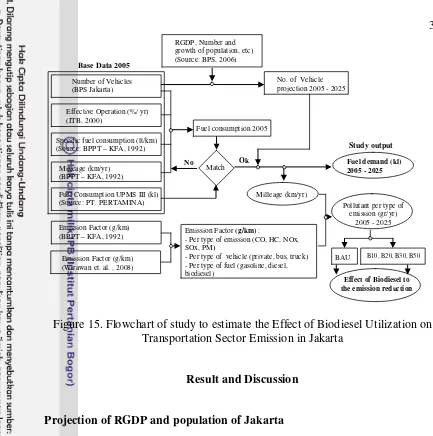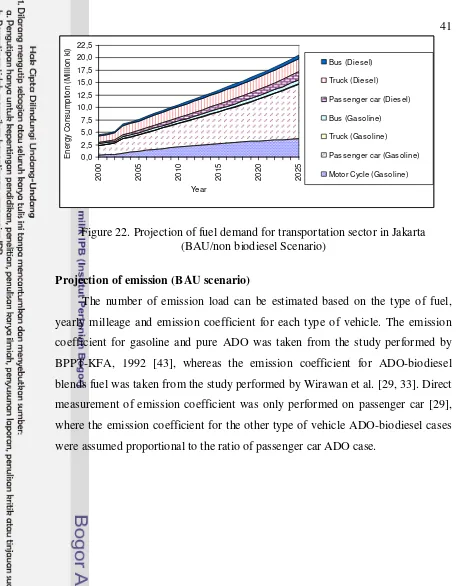THE EFFECT OF BIODIESEL UTILIZATION IN
TRANSPORTATION SECTOR TO POLLUTANT EMISSION AND
EXTERNAL COST: CASE STUDY JAKARTA
(
EFEK PENGGUNAAN BIODIESEL PADA EMISI POLUTAN DAN BIAYA
EKSTERNAL DI SEKTOR TRANSPORTASI: STUDI KASUS JAKARTA
)
SONI SOLISTIA WIRAWAN
A Dissertation
Submitted in partial fulfillment of the requirements for the Degree of Doctor in Agricultural Engineering Sciences
THE GRADUATE SCHOOL
BOGOR AGRICULTURAL UNIVERSITY (IPB)
BOGOR
i.
STATEMENT OF RESEARCH ORIGINALITY
Hereby, I state that the dissertation entitled “The Effect of Biodiesel
Utilization in Transportation Sector to Pollutant Emission and External
Cost: Case Study Jakarta.” is my own work, which has never previously been
published in any university. All of incorporated originated from other published as
well as unpublished papers are stated clearly in the text as well as in the
references.
Bogor, June 2009
Soni Solistia Wirawan
ii
ABSTRACT
SONI SOLISTIA WIRAWAN. The Effect of Biodiesel Utilization in
Transportation Sector to Pollutant Emission and External Cost: Case Study Jakarta. Under direction of ARMANSYAH H. TAMBUNAN, MARTIN DJAMIN, HIROSHI NABETANI, and ARIEF SABDO YUWONO.
World wide numerous studies have proved that biodiesel is an environmentally friendly alternative diesel fuel. Biodiesel is essentially sulphur free and engines fueled by biodiesel emit significantly fewer particulates, hydrocarbons and less carbon monoxide than that of operating conventional diesel fuel. The maximum utilization of biodiesel in Indonesia could improve the air quality level in major cities especially in Jakarta. The most significant hurdle for broader commercialization of biodiesel in Indonesia is its cost. Thus acceptance of biodiesel in Indonesia is more influenced by pricing factor. The advantages of biodiesel such as a renewable energy, lower exhaust gas emission and effect to the longer engine life time are often ignored.
The objective of this research was to assess the effect of biodiesel utilization in transportation sector to the air pollution level, health and economic impact which could be transferred into monetary values in the term of external-cost. Jakarta was selected as a targeted research location due to the fact that Jakarta is the capital city with the most densed population, highest mineral diesel fuel consummer, and most polluted city compared to other big cities in Indonesia
The targeted emission in the study were carbon monoxide (CO), nitrogen oxides (NOx), hydrocarbons (HC), sulphur dioxide (SO2) and particulate matter (PM)
from vehicle sources. The external cost of B10 and B20 utilization in 2010, 2015, 2020 and 2025 scenarios compared to the base (non biodiesel) case (B0) in 2005 was calculated by using the analysis of emission dispersion effect method which is most known as Impact Pathway Analysis (IPA). The method consisted of four steps, that are : to quantify the emission, to define the dispersion and transformation of emission for calculating the ambient concentration, to estimate the physical effects by using the dose response function, and to determine the monetary value of the damage for calculating the external costs.
The result showed that utilization of biodiesel could potentially improve air quality level in Jakarta. The utilizations of B10 and B20 in 2010 compared to the base (non-biodiesel) case may reduce external cost by 13.4 and 59.0 billion Rupiah and they increase by 25.2 and 105.7 billion Rupiah in 2025. Since those values may rise as biodiesel blend composition is increased, it necessitates performing simulation on B50 and B100 scenarios. External cost reduction may achieve its maximum value of 447.7 billion Rupiah when B100 is introduced in 2025. Taking into account the diesel fuel consumption for the transportation sector in 2010 and 2025, the reduction translates into external cost of Rp. 4 to 18 per liter for B10 and B20 respectively. Moreover, provided such a diesel engine fueled by B100 is available, the external cost reduction could reach up to Rp. 90 per liter. The implication of this finding suggests that the polluter (motorist) should be willing to pay additional 4 to 90 Rupiah per liter depending on the biodiesel content in the diesel fuel blend.
iii
SUMMARY
SONI SOLISTIA WIRAWAN. The Effect of Biodiesel Utilization in
Transportation Sector to Pollutant Emission and External Cost: Case Study Jakarta. Under direction of ARMANSYAH H. TAMBUNAN, MARTIN DJAMIN, HIROSHI NABETANI, and ARIEF SABDO YUWONO.
Biodiesel development in Indonesia has been started since more than ten years ago but gained significant milestones in 2006 when the Indonesian government issued formally blending permit regulation of 10% biodiesel with mineral diesel fuel and PERTAMINA (Mineral oil State owned company) launched biodiesel blend B5 formally at public gasoline station with the trade name of BIOSOLAR. To continue reducing Indonesia’s dependency on fossil resources for its energy source and to improve the air quality level in its major cities, PERTAMINA has been expanding BIOSOLAR market at almost all fuel outlets in Java and will continuously open outlets in all parts of Indonesia. Moreover, the state owned company will increase the blending content at least up to B20 in 2025 as stated on President Decree No. 5/2006 regarding the National Energy Policy.
Despite efforts by the government and Pertamina, broader commercialization of biodiesel in Indonesia could not achieve its target. The most significant hurdle found is its cost. In addition, the consumers mostly still consider the fuel price in selecting the fuel for their cars. Fluctuation of biodiesel price which is usually higher than that of mineral diesel and lack of subsidy given to biodiesel cause the price of biodiesel blend fuel is often higher than the standard mineral diesel fuel. On the other hand, the advantages of biodiesel such as a renewable energy, lower exhaust gas emission and effect to the longer engine life time is often ignored. Overcoming these drawbacks is by imposing the “polluter pay principle” which would internalize as many of the externalities. Having derived monetary values to reflect the external costs of differing technologies, the next step is to devise a mechanism for “internalizing” them into market prices.
The objective of this research was to assess the effect of biodiesel utilization in transportation sector to the air pollution level, health and economic impact which could be transferred into monetary values in the term of external-cost. Jakarta was selected as a targeted research location due to the fact that Jakarta is the capital city with the most densed population, highest mineral diesel fuel consummer, and most polluted city compared to other big cities in Indonesia. The
targeted emission in the study are carbon monoxide (CO), nitrogen oxides (NOx),
hydrocarbons (HC), sulphur dioxide (SO2) and particulate matter (PM) from
vehicle sources. The study will determine the external costs of transportation energy use using model simulations. Each simulation was based on the scenario in line with the development pattern of government policy. By comparing the base case (B0) with biodiesel blends cases (B10, B20, B50, B100) for the projection year until 2025, the strategy for reducing the external costs could be compiled.
iv policy application related studies. The method consists of four steps, that are : to quantify the emission, to define the dispersion and transformation of emission for calculating the ambient concentration, to estimate the physical effects by using the dose response function, and to determine the monetary value of the damage for calculating the external costs.
The application of IPA starts from identifying emission sources, defining the emission source characteristics, and determining the type of emission which will be analyzed. Each type of vehicle has a specific emission coefficient depending on its technology and the type of fuel used. Specific study on the performance and emission evaluation on automotive diesel engine as affected by palm biodiesel fuel utilization has been conducted. The result shows that the
emission of CO, HC, SO2 and PM decreased considerably with the increase in
biodiesel blend. The reduction in particle emission was very sharp at 10% blend (B10), while the sharp reduction in HC emission started at 20% blend (B20). In contrast to those generally found in the previous non palm biodiesel studies, the
results in this study shows lower NOx emission as well as higher torque and power
for biodiesel blend compare to that of pure petro-diesel fuel. This result could be as a consequence of the properties of the tested palm biodiesel, which has higher cetane number and lower viscosity value compared to the petro-diesel fuel sample. This study result was used for determining the emission coefficient for the model input. Two cases (low and high) of emission coefficient was determined for the model input.
Second step of the Impact Pathways Analysis is calculation of pollutant
concentration changes (dispersion). These predictions are carried out by
simulating air pollutant concentration or dispersion model. An ideal air pollutant concentration model should be able to predict the amount of specific pollutant emission, for any specified meteorological condition, at any location, for any time of period, with sufficiently reliable confident level. Several aspects should be considered when selecting a good model and they have to be:
(i) suitable with the study objective,
(ii) Simple and easy to operate and
(iii) calibrated and model precission have been proven and used by other similar
projects.
This study employs the MLuS model because it is simple model, suitable for movable emission source, capable in estimating the pollutant concentration near roadside. In addition many projects in Europe as well as in Indonesia have used this model for their simulation. For this study, vehicle emission is categorised as a line source emission.
Results evaluation of the performed two cases of studies (low and high emission cases) and validation against previous Jakarta’s air quality studies have concluded that the result of external cost of high emission coefficient case is more acceptable. The reason is that low emission coefficient data was determined from almost latest diesel engine tecnology (produced between years 2004 – 2008) and has utilised direct injection method. Thus, the emission coefficient was too small.
v 133.7 billion rupiah for B50 case and reached up to 245 billion rupiah for B100. The cost increases as a function of time due to the continuously growing of fuel consumption and population density. Introducing B20 in 2025 will increase the external cost reduction of 105.7 billion rupiah and reach the maximum value of 447.7 billion Rupiah when B100 used in 2025.
vi
RINGKASAN
SONI SOLISTIA WIRAWAN. The Effect of Biodiesel Utilization in
Transportation Sector to Pollutant Emission and External Cost: Case Study Jakarta. Under direction of ARMANSYAH H. TAMBUNAN, MARTIN DJAMIN, HIROSHI NABETANI, and ARIEF SABDO YUWONO.
Pengembangan biodiesel di Indonesia telah dimulai sejak lebih dari sepuluh tahun yang lalu. Akan tetapi kemajuan yang signifikan baru dicapai pada tahun 2006, sejak pemerintah Indonesia secara resmi mengeluarkan ijin pencampuran biodiesel dengan minyak solar maksimum 10% (B10) dan PERTAMINA mulai resmi menjual bahan bakar campuran biodiesel-solar B5 di stasiun pompa pengisian bahan bakar umum (SPBU) dengan merek dagang BIOSOLAR. Untuk mengurangi ketergantungan kepada Bahan Bakar Minyak (BBM) dan memperbaiki tingkat kualitas udara (terutama di kota-kota besar), maka PERTAMINA memperluas penjualan BIOSOLAR dengan membuka outlet di seluruh SPBU di Pulau Jawa dan akan terus membuka di semua wilayah yang tersebar di seluruh Indonesia. Kandungan biodiesel pada campuran juga akan ditingkatkan terus hingga mencapai komposisi B20 pada tahun 2025, sesuai dengan yang target yang telah ditetapkan pada Surat Keputusan Presiden No. 5/2006 tentang Kebijakan Energi Nasional.
Ada beberapa kendala yang menghambat pencapaian target komersialisasi biodiesel oleh PERTAMINA. Hambatan terbesar adalah masalah harga. Faktor harga masih menjadi pertimbangan yang dominan bagi masyarakat di Indonesia dalam menentukan pilihan bahan bakar untuk digunakan pada kendaraannya. Harga biodiesel masih cenderung lebih mahal daripada minyak solar, karena hingga saat ini biodiesel masih dikategorikan dalam klasifikasi “bahan bakar lain” yang harus dijual pada harga keekonomian dan tidak mendapatkan subsidi. Di sisi lain, kelebihan biodiesel sebagai bahan terbarukan yang lebih ramah lingkungan dan memiliki kelebihan terhadap unjuk kerja dan umur mesin masih kurang dipertimbangkan. Salah satu cara untuk mengatasi permasalahan harga ini adalah
dengan menerapkan prinsip “polluters pay principle”.
Produsen produk yang menghasilkan polutan wajib membayar sejumlah
tertentu kepada masyarakat yang terkena polutan (polluters pay principle) atau
melakukan upaya agar polutan yang dihasilkan tidak melebihi ambang batas yang ditentukan. Karena produsen dikenai biaya tambahan maka produsen akan membebankan biaya tambahan ini ke dalam harga produk yang dihasilkan. Konsep yang demikian ini disebut internalisasi eksternalitas. Besaran nilai biaya eksternal dapat dibedakan dari jenis teknologi pembuatan produknya. Setelah nilai biaya eksternal ditentukan, maka langkah selanjutnya adalah menentukan mekanisme dan cara untuk menginternalisasi eksternalitas tersebut ke dalam harga pasar.
vii paling banyak dan sebagai kota dengan tingkat polusi paling tinggi dibandingkan dengan kota-kota besar lainnya yang ada di Indonesia. Jenis emisi yang dihitung
pada penelitian ini adalah karbon monoksida (CO), nitrogen oksida (NOx),
hidrokarbon (HC), sulphur dioksida (SO2) and partikel (PM) yang dilepaskan dari
kendaraan bermotor. Penentuan biaya eksternal dari penggunaan energi di sektor transportasi pada penelitian ini dilaksanakan melalui suatu perhitungan simulasi dengan mempertimbangkan skenario pengembangan BBN seperti yang telah ditetapkan oleh pemerintah. Strategi untuk mengurangi biaya eksternal dapat ditentukan dengan cara membandingkan kasus dasar (B0) dengan kasus penggunaan berbagai komposisi campuran biodiesel-solar (B10, B20, B50, B100) untuk proyeksi tahun 2005 hingga tahun 2025.
Biaya eksternal dihitung menggunakan analisis penyebaran dampak dari
emisi atau lebih dikenal dengan sebutan Impact Pathway Analysis (IPA). Metode
yang telah banyak digunakan pada berbagai proyek penelitian di dunia ini, terdiri atas empat tahapan yaitu: melakukan kuantifikasi emisi, menentukan penyebaran dan transformasi emisi untuk menghitung konsentrasi ambien, mengestimasi
dampak fisik dengan menggunakan fungsi dose respons, dan menentukan nilai
moneter dari kerusakan untuk menghitung biaya eksternal.
Penerapan IPA dimulai dari identifikasi sumber emisi, menentukan karakteristik sumber emisi, serta menentukan jenis emisi yang akan dianalisis. Setiap jenis kendaraan mempunyai koefisien emisi tertentu tergantung dari teknologi dan jenis bahan bakar yang digunakan. Hasil evaluasi dari studi dampak penggunaan biodiesel terhadap unjuk kerja mesin dan emisi yang telah dilakukan
menunjukan bahwa emisi CO, HC, SO2 dan PM berkurang dengan bertambah
besarnya komposisi biodiesel dalam campuran minyak solar.
Pengurangan emisi partikel sangat tajam pada komposisi campuran biodiesel 10% (B10), sedangkan pengurangan emisi HC yang tajam dimulai pada campuran B20. Berbeda dengan hasil yang dikemukakan pada hasil studi biodiesel non sawit pada umumnya, hasil evaluasi biodiesel sawit pada studi ini menunjukkan
penurunan emisi NOx dan lebih besarnya torsi dan daya dari campuran biodiesel
dibandingkan dengan mesin berbahan bakar minyak solar murni. Hasil yang berbeda ini mungkin sebagai akibat dari sampel biodiesel sawit yang diuji memiliki angka setana yang lebih besar dan viskositas yang lebih kecil dibandingkan dengan sampel minyak solar murni yang diuji. Koefisien emisi yang dihasilkan dari studi ini digunakan sebagai salah satu dari beberapa literatur yang digunakan dalam menentukan koefisien emisi untuk input model. Simulasi perhitungan dilakukan dengan menggunakan dua kasus harga koefisien emisi, yaitu kasus harga koefisien emisi yang rendah dan tinggi sebagai data input.
viii model sudah dibuktikan penggunaannya pada proyek yang sejenis. Emisi dari
kendaraan bermotor diklasifikasikan sebagai sumber emisi yang bergerak (line
source). Model MluS dipilih untuk digunakan pada penelitian ini dengan alasan bahwa MluS merupakan model yang sederhana, sesuai untuk sumber emisi bergerak, model cocok untuk memperkirakan besarnya konsentrasi dekat pinggir jalan dan model ini juga telah banyak digunakan dalam banyak proyek baik di negara-negara Eropa maupun di Indonesia.
Evaluasi hasil simulasi dari dua kasus yang diteliti (kasus koefisien emisi rendah dan tinggi) dan setelah di validasi dengan data hasil penelitian kualitas udara di Jakarta sebelumnya, dapat disimpulkan bahwa besarnya biaya eksternal dari hasil perhitungan kasus koefisien emisi tinggi lebih dapat diterima. Hal ini mungkin disebabkan karena kasus harga koefisien emisi rendah ditentukan dari data mesin diesel dengan teknologi tinggi (kendaraan bermesin diesel yang diproduksi antara tahun 2004 sd 2008 dan telah menggunakan teknologi injeksi
langsung (direct injection technologi)), sehingga harga koefisien emisi yang
didapatkan terlalu rendah.
Hasil perhitungan menunjukkan bahwa dibandingkan dengan kasus dasar (tidak menggunakan biodiesel) pada tahun 2005, pengurangan biaya eksternal sebagai dampak dari penggunaan biodiesel pada tahun 2010 meningkat secara bertahap dari mulai 13,4 milyar rupiah untuk kasus B10, menjadi 59 milyar rupiah untuk B20, 133,7 milyar rupiah untuk B50 dan mencapai harga 105,7 milyar rupiah untuk B100. Nilai tersebut meningkat terus dengan fungsi waktu, meningkatnya kepadatan penduduk dan bertambahnya konsumsi bahan bakar. Pengurangan biaya eksternal maksimum sebesar 447,7 milyar rupiah dicapai ketika B100 digunakan pada tahun 2025.
Cara yang paling sederhana untuk menginternalisasi eksternalitas dari penggunaan biodiesel adalah dengan menambahkan harga estimasi biaya eksternal ke dalam harga produk yang nantinya akan dibayar langsung oleh pengguna
bahan bakar (polluter). Pada penelitian ini harga biaya eksternal dapat diestimasi
dengan membagi besarnya biaya eksternal dengan konsumsi minyak solar. Hasil menunjukkan bahwa dibandingkan dengan kasus dasar (tidak menggunakan biodiesel) , pengurangan biaya eksternal akan meningkat mulai dari 4 rupiah per liter pada skenario penggunaan B10 di tahun 2010 sampai dengan maksimum 90 rupiah per liter pada skenario B100 di tahun 2025. Hasil ini mungkin terkesan terlalu kecil untuk menarik pemeritah daerah DKI Jakarta untuk merealisasikan program pemanfaatan biodiesel sebagai bahan bakar yang ramah lingkungan. Akan tetapi mesti diingat bahwa biaya eksternal dari penurunan emisi ini hanyalah salah satu biaya eksternal yang dapat dihitung dan diinternalisasikan ke harga produk. Kelebihan lain dari biodiesel yang merupakan bahan bakar terbarukan, mendukung program pemenuhan energi yang berkelanjutan,
merupakan bahan bakar yang mudah terurai (biodegradable), dapat
ix
@ Copyright 2009 by IPB
All rights reserved
1. No part or all of this dissertation may be excerpted without inclusion or mentioning the sources
a. excerption only for research and education use, writing for scientific papers, reporting, critical writing or reviewing of a problem.
x
THE EFFECT OF BIODIESEL UTILIZATION IN
TRANSPORTATION SECTOR TO POLLUTANT EMISSION
AND EXTERNAL COST: CASE STUDY JAKARTA
(EFEK PENGGUNAAN BIODIESEL PADA EMISI POLUTAN DAN
BIAYA EKSTERNAL DI SEKTOR TRANSPORTASI: STUDI KASUS
JAKARTA)
by
SONI SOLISTIA WIRAWAN
A Dissertation
Submitted in partial fulfillment of the requirements for the Degree of Doctor in Agricultural Engineering Sciences
THE GRADUATE SCHOOL
BOGOR AGRICULTURAL UNIVERSITY
BOGOR
The external assessor for closed examination are:
1.
Dr. Ir. Abdul Kohar I., M.Sc.
2.
Dr. Dadan Kusdiana
The external assessor for opened examination are:
1.
Dr. Ir. Y. Aris Purwanto
xi to Pollutant Emission and External Cost: Case Study
Jakarta
Name : Soni Solistia Wirawan
NIM : F161060032
Approved by,
Advisory Committee
Prof. Dr. Armansyah H. Tambunan Prof. (R). Dr. Martin Djamin, M.Sc.
Chairman Member
Prof.Dr. Hiroshi Nabetani Dr. Arief Sabdo Yuwono
Date of Examination: Date of Graduation:
Member Member
Acknowledged by,
Head of Study Program in Dean of the Graduate School
Agricultural Engineering Science
xii
ACKNOWLEDGMENT
For the completion of this dissertation I would like to express my most
profound gratitude to Prof. Dr. Armansyah H. Tambunan as the chairman of the
advisory committee and all members of advisory committee; Prof. (R). Dr.
Martin Djamin, Msc., Prof. Dr. Hiroshi Nabetani and Dr. Arief Sabdo Yuwono for
all valuable assistance, supports and their tireless and patient counsel.
I wish to express my sincere appreciation to Dr. Kusmayanto Kadiman, the
Minister of Ministry of Research and Technology for introducing me to the
“Program Rintisan Pendidikan Gelar Pascasarjana - KNRT” and motivate me to
pursue this study program. To Dr. Marzan A. Iskandar, the Chairman of BPPT for
his permission and support. I would like also to express my appreciation to Prof.
(R). Dr. Wahono Sumaryono for his assistance and constant motivation. To Prof.
Dr. Ir. Prawoto, MSAE and Dr. Dadan Kusdiana who have reviewed our article
for international journal publication. Particular thanks are also due to Ir. Agus
Sugiyono, M.Eng. who introduced me to the MLuS dispersion model, to Ir.
Rizqon Fajar, M.Eng. for valuable discussion on vehicle emission coefficient
related topic. To all members of BRDST-BPPT and Agricultural Engineering
Science Study Program of IPB, who have contributed in various ways to the
completion of this dissertation. I would like also to express my appreciation for
the support of the following institutions: BRDST-BPPT, BTMP-BPPT, PT.
Toyota Astra Motor, PT. Pertamina, BMG, Balai Teknologi Kesehatan dan
Lingkungan (BTKL) and Dinas Lalu Lintas Jalan Raya DKI Jakarta. To the
Government of Indonesia through the “Program Rintisan Pendidikan Gelar
Pascasarjana - KNRT” scholarship program. Thanks to Prof. Dr. Ir. Carunia M.
Firdausy, MA., APU and team members who organize this scholarship program.
Finally, I would like to dedicate this research work to my family, my wife
(Ika Sandra), my daughters (Nike Nadia and Daniya Fathiya) and my sons (Noval
Hudiya and Dafa Fadiya), for their love, continuous encouragement and constant
support in my life.
Bogor, June 2009
xiii
BIOGRAPHY
Soni Solistia Wirawan (author) was born in Bandung on October 10th, 1961 as the youngest of the four children of father Sujud Andjar Sumyana and mother
Kustinah Djajadiredja. In 1980, he was graduated from SMAN III Bandung and
continued his under graduate study in Mechanical Engineering Faculty of
Brawijaya University in Malang and graduated in 1986. He continued his study in
Master Degree Program in Mechanical System Engineering Department of
Nagaoka University of Technology, Japan in 1996 with scholarship from the
government of Japan (Mombusho) and was graduated in 1998. In 2006 he got
scholarship for PhD by research program in Agricultural Engineering Science, the
Graduate School, Bogor Agricultural University (IPB) from The Ministry for
Research and Technology of Indonesia. Author has been working as a researcher
at The Agency for the Assessment and Application of Technology (BPPT) since
1987 and since 2002 up to now he is responsible as the head of Engineering
Center - BPPT.
During his study in PhD program, one of his paper “The Current Status and
Prospects of Biodiesel Development in Indonesia: a review” has been presented at
the third Asia Biomass Workshop in Tsukuba, Japan, on November 17, 2006.
Four papers have been published in accredited national and international scientific
journal; a paper titled “The Effect of Palm Biodiesel Fuel on the Performance and
Emission of the Automotive Diesel Engine” has been published in the CIGR
Ejournal. Manuscript EE 07 005. Vol. X, April. 2008. A paper titled “Validation
of Measured Blend Biodiesel–Mineral Diesel Specification by Using a Simple
Calculation Method” has been published in Jurnal Keteknikan IPB, Vol. 21 No. 3,
September 2008. A paper titled “Study of Effect of Biodiesel Utilization to the
Transportation Sector Emission in Jakarta” has been published in Jurnal
Teknologi Lingkungan BPPT, Vol. 9 No. 2, Mei 2008. And a paper titled “Study
of Determinantion of Optimum Composition of Biodiesel-Petrodiesel blend Fuel”,
has been published in Majalah Teknologi Lingkungan BPPT, Vol. 4 No. 2, May
2008. All of above mentioned papers were written as a part of the author’s PhD
xiv
LIST OF CONTENTS
LIST OF TABLES ………...
LIST OF FIGURES ……….
LIST OF APPENDICES ……….
LIST OF NOMENCLATURE ……….
LIST OF ABBREVIATIONS ………..
1. INTRODUCTION
Background of the Research ………
Objective of the Research ….………
Benefit of the Research ………... …….……
Boundaries and Methodology ………..
Outline of Dissertation ……….
2. THE EFFECT OF PALM BIODIESEL FUEL ON THE
PERFORMANCE AND EMISSION OF THE AUTOMOTIVE DIESEL ENGINE
Introduction ………...
Materials and Methods ...
Result and Discussion ...
Conclusion ...
3. THE EFFECT OF BIODIESEL UTILIZATION ON
TRANSPORTATION SECTOR EMISSION IN JAKARTA
Introduction ………...
Materials and Methods ...
Result and Discussion ...
Conclusion ...
4. BIODIESEL BLENDING SCENARIO
Introduction ………...
Materials and Methods ...
Result and Discussion ...
xv Introduction ………...
Materials and Methods ...
Result and Discussion ...
Conclusion ...
6. EXTERNAL COST ANALYSIS
Introduction ………...
Materials and Methods ...
Result and Discussion ...
Conclusion ...
7. GENERAL DISCUSSION ………
8. CONCLUSIONS ………...
REFERENCES ………..
APPENDICES ...
58
60
65
100
102
106
109
117
119
129
131
138
xvi
LIST OF TABLES
1 2 3 4 5 6 7 8 9 10 11 12 13 14 15 16 17 18 19 20 21 22 23 24 25
Comparison of fossil diesel fuel with vegetable oil characteristic ...
Vegetable Oil Methyl Esters (VOME) characteristic ...
Current worldwide production of nine major vegetable oils...
Potential vegetable oil plants in Indonesia …………...
Characteristics of pure petro-diesel and biodiesel used in the research
Emission of biodiesel blend as compared to euro II regulation ...
Reduction in Health Costs caused by the Abatement Policies ...
The list of the growth of vehicle number projection input data ………
Parameters for vehicle number projection ……….
Specific fuel consumption, mileage and yearly effective operation ...
Emission factor for each type of vehicles ……….
Comparison of emission value of BAU and biodiesel scenario ...
Comparisons of Fossil Diesel Fuel (FDF) and Biodiesel Fuel (BDF)
characteristics ………...
Comparison of SNI 04-7182-2006, and B20 (EMA) ...
Diesel oil 48 specification ……….
Price of biodiesel-petrodiesel blend ...
Relatif toxicity of air pollutant ...
The value of emission parameter ...
The value of emission and engine performance parameter (short term
engine effect) ...
The score of long term engine effect ...
The score of price parameter ...
The ranking of optimum biodiesel-petrodiesel composition ...
Energy source type reated to sector ...
Comparison between gaussian and MLuS model ...
Standard qualification and air qualities by measure location
in the year of 2006 ……….
xvii 27 28 29 30 31 32 33 34 35 36 37 38 39 40 41 42 43 44 45 46 47 48 49 50 51 52 53 54 55
Deviation of calculated grids compare to and BPS existing data …….
Population per area of DKI Jakarta ………...
Population projection at district in DKI Jakarta ………
Road length based on district area (in meter), 2006 ...
Vehicle number at selected case, 2005 road (base) ………..
Traffic density classification ………
Volume of vehicle passing the toll road according to BPS …………..
Projection of vehicle number and AADT ……….
Share of each type of vehicle ………
Emission coefficient (g/km) according to BPPT – KFA study ………
Emission coefficient (g/km) according to Lestari’s study …………...
Emission coefficient (g/km) according to MoE ………
Formula for the correlation between the masured engine capacity and
emision coefficient (regression result) ...
The value of coefficient a according to EPA ...
Emission coefficient (g/km) according to Fajar’s study ...
Specific fuel consumption for each type of vehicle ...
Emission coefficient (g/l) according to Fajar’s study ...
High emission coefficient case (g/km) ...
Average wind velocity by observation station in Jakarta, 2006 ………
Meteorological data ...
German reference concentration Ki*(source: MLuS) ...
German average emission coefficient e* (source: MLuS) ...
Emission concentration of CO at several location ...
AADT and CO emission concentration in year 2002 ...
Reference emission coefficient e* for model input ...
Reference concentration K* for model input ...
Total emission (in thousand ton), low emission coefficient case ……..
Emission reduction (thousand ton), low emission coefficient case …...
Emission concentration (mg/m3), low emission coefficient case ……..
xviii 57 58 59 60 61 62 63 64 65 66 67 68 69 70 71 72 73 74 75 76 77 78 79 80
low emission coefficient case ………..
Total emission (thousand ton), high emission coefficient case ……….
Emission reduction (thousand ton), high emission coefficient case ….
Emission concentration (mg/m3), high emission coefficient case …….
Reduction of emission concentration compare to base scenario,
high emission coefficient case ………...
Comparison between emission load and concentration for low and
high emission coefficient for year 2010 case ...
Reported health impacts of major diesel engine exhaust component ...
Regulated exhaust emission reduction of B30 ...
Non-regulated emission of aromatic compounds from fossil diesel
fuel (FDF) and B30 ………..
Dose response ...
Health cost ……….
GDPPPP and GDPPPP/capita for Indonesia and German case ...
Indonesian GDP Deflator 1990 – 2005 ...
Low emission coefficient external cost summary ……….
External cost reduction compare to base scenario ………
High emission coefficient external cost summary ………
External cost reduction compare to base scenario ………
Comparison between low and high emission coefficient value ………
Comparison of external cost estimation result with others existing
studies (in Trillion Rupiah) ………...
The ranking of optimum biodiesel-petrodiesel composition ...
Environmental Impact Classification ...
External value should be paid by the polluter (Rp. Per liter) …………
Emission coefficient data sources (g/km) ………..
External cost (rupiah), low emission coefficient case ………...
External cost (rupiah), high emission coefficient case ………..
xix
LIST OF FIGURES
1 2 3 4 5 6 7 8 9 10 11 12 13 14 15 16 17 18 19 20 21 22 23 24 25 26 27
The logical frame of the research ...
External Costs Calculation by Impact Pathway Analysis ...
External cost simulation flow chart...
Base catalyzed transesterification reaction ...
Typical biodiesel process flow diagram ...
The arrangement of emission test on chassis dynamometer ...
Biodiesel test sample Process Flow Diagram ...
Biodiesel plant 1.5 ton/day capacity at PUSPIPTEK, Serpong...
Emission test cycle based on ECE 83-04 ...
Power Vs. engine speed ...
Torque Vs engine speed ...
Emission profile ...
Fuel consumption VS biodiesel blending composition ...
The effect of biodiesel on exhaust gas emission ...
Flowchart of study to estimate the effect of biodiesel utilization on
transportation sector emission in Jakarta ……….
RGDP and population in Jakarta ………..
Projection of population and RGDP in Jakarta ………..
Fuel sold by UPMS III in the year of 2005 ………...
Number of vehicles in Jakarta 2001 – 2005 ………
Estimated fuel consumption for transportation sector in Jakarta ……..
Projection of vehicle number in Jakarta ………
Projection of fuel demand for transportation sector in Jakarta
(BAU/non biodiesel Scenario) ...
Projection of emission (BAU scenario) ………
Optimum blending determination flow chart ……….
Basic calculation of concentration (MluS model) ...
Fading function g(s) ...
Average relative pollutant concentration ...
xx 29 30 31 32 33 34 35 36 37 38 39 40 41 42 43 44 45 46 47 48 49 50
Main program flow chart ………
Data grids matrices of Jakarta’s area ………..
Jakarta’s map digitalization ...
Jakarta’s road grid data ………..
Hourly vehicle volume ...
The view of WRPLOT Software ...
WRPLOT format ...
Yearly windrose for 2001 – 2005 ………..
Monthly wind rose for 2005 ...
The dispersion map of SO2 emission concentration for base case …….
External cost, low emission coefficient case ……….
External cost reduction, low emission coefficient case ……….
External cost, high emission coefficient case ……….
External cost reduction, high emission coefficient case ……….
Sensitivity of emission coefficient to each pollutant concentration ...
The sensitivity of emission coefficient value to the external cost ...
Sensitivity of wind speed to each pollutant concentration ...
The sensitivity of wind speed to the external cost ...
Sensitivity of fading function to each pollutant concentration ...
The sensitivity of fading function to the external cost ………..
Price structure comparison ...
The cartesian co-ordinate system used to specify dispersion geometry
for Gaussian Dispersion Model ...
xxi
LIST OF APPENDICES
1
2
3
4
5
The emission coefficient estimation determination method
Gaussian plume mathematical diffussion model ...
Map region, population and AADT ...
Emission concentration dispersion map ...
External cost calculation result ...
Page
138
140
144
147
xxii
LIST OF NOMENCLATURE
AADT
AADTG
C(x,y,z)
Ds
ei*
ei f fvi fu g g(s) H Hf Δh H ∆Hc IGAV
Ki*
Q
s
s0
s
Ts
Annual Average Daily Traffic
AADT for German reference case
air concentration at receptor point (x,y,z)
stack diameter
Average specific reference emission factor of the
pollutant i
Average emission factor of the pollutant i coming
from an independent emission model i
Briggs plume rise stability factor
Function to consider the traffic data
Function to consider the meteorological data
gravitational acceleration
Fading function of the relative pollutant
concentrations
Effective height
Effective height as a function of f factor
Plume rise
Stack height
Combustion Heat
The average relative concentration
Reference concentration at ground level near
roadside of the pollutant i
Emission strength
Stability parameter
A distance from the roadside that relative
concentration of the considered pollutants reach
zero
Distance from the roadside
Stack gas temperature
[vehicle/day]
[vehicle/day]
[kg/m3] [m] [g/km, g/l] [g/km, g/l] [-] [-] [-]
[m/s2]
[-] [m] [m] [m] [m] [MJ/kg, MJ/liter]
[mg/m3]
[mg/m3, ug/ m3] [kg/s]
[-]
[m]
[m]
xxiii u
u
Vs
x
xf
γ
σy(x)
σz(z)
Wind speed in effective height
Annual average wind speed in a height of 10 m
above ground
Stack gas velocity
Downwind distance
Downwind distance as a function of f
Greek Symbols
Elasticity factors
Horizontal dispersion parameter
Vertical dispersion parameter
[m/s]
[m/s]
[m/s]
[m]
[m]
[-]
[m]
[m]
xxiv
LIST OF ABBREVIATIONS
AADT
ADO
ADB
APROBI
ASTM
BAU
BDF
BMG
BPLHD
BPPT
BRDST
BTMP
BPS
BSN
B10
C
CD
CO
CO2
CNG
CPO
CVS
Annual Average Daily Traffic
Automotive Diesel Oil
Asean Development Bank
Assosiasi Produsen Biofuel Indonesia (Indonesian Biofuel
Producer Association)
American Society of Testing and Materials
Business As Usual
Biodiesel Fuel
Badan Meteorologi dan Geofisika (Indonesian Bureau of
Meteorology and Geophysics)
Badan Pengelola Lingkungan Hidup Daerah (Local
Environmental Management Agency)
Badan Pengkajian dan Penerapan Teknologi (Agency for the
Assessment and Application of Technology)
Balai Rekayasa Desain dan Sistem Teknologi (Institute for
Engineering and Technology System Design)
Balai Termodinamika, Motor dan Propulsi (The
Thermodynamics and Propulsion Engine Research Center)
Badan Pusat Statistik (Statistics DKI Jakarta Provincial Office)
Badan Standarisasi Nasional (National Standardization Agency)
Mixture of 90% vol. fossil diesel fuel with 10% vol. biodiesel
Carbon residue
Chassis Dynamometer
Carbon Monoxide
Carbon dioxide
Compressed Natural Gas
Crude Palm Oil
xxv DKI Jakarta
EC - BPPT
EPA EMA ERF FAME FFA FDF GDP GNP HC
H2O
IDO IPA IPB ITB LEMIGAS LPG LNG MFO MoE NO2 NOX PAH PERTAMINA PM PM10
Energy and Mineral Resources)
Daerah Khusus Ibu Kota Jakarta (The Capital City of Jakarta)
Engineering Center - BPPT
Environmental Protection Agency
Engine Manufacturers Association
Exposure-Response Functions
Fatty Acid Methyl Ester
Free Fatty Acid Distillate
Fossil Diesel Fuel
Gross Domestic Product
Gross National Product
Hydrocarbon
Water vapor
Industrial Diesel Oil
Impact Pathway Analysis
Institut Pertanian Bogor (Bogor Agricultural University)
Institut Teknologi Bandung (Bandung Institute of Technology)
Pusat Penelitian dan Pengembangan Teknologi Minyak dan Gas
Bumi (Research and Development Centre for Oil and Gas
Technology)
Liquid Petroleum Gas
Liquid Natural Gas
Marine Fuel Oil
Ministry of Environment
Nitrogen Dioxide
Oxides of Nitrogen
Polyaromatic Hydrocarbons
State Own Oil Company
Particulate Matter
xxvi PUSPIPTEK
RGDP
PPPGDP
SFS
SNI
SOF
SOx
SO2
SPBU
SPM
SUTP
THC
TSP
UPMS III
USA
VHA
VOF
VOME
YOLL
Pusat Pengembangan Ilmu Pengetahuan dan Teknologi (Science
and Technology Research Center)
Regional Gross Domestic Product
Purchasing Power Parity Gross Domestic Product
Specific Fuel Consumption
Standar Nasional Indonesia (Indonesian National Standard)
Soluble Organic Fraction
Sulphur Oxides
Sulphur Dioxide
Stasiun Pengisian Bahan Bakar Umum (Public Fuel Pump
Station)
Suspended Particulate Matter
Sustainable Urban Transport Project
Total Hydrocarbon
Total Suspended Particle
PERTAMINA’s Marketing Unit III
United State of America
Volatile Hydrocarbon
Volatile Organic Fraction
Vegetable Oil Methyl Ester
CHAPTER I
INTRODUCTION
Background of the Research
Energy consumption in Indonesia increases rapidly in line with economic
and population growth. Currently, Indonesia is very much dependent on fossil fuel
for its energy sources and the non fossil alternative renewable energy has not been
utilized optimally. Data of fossil energy reserves from the Department of Energy
and Mineral Resources [1] shows that the proven reserve of oil is about 9 billion
barrels and with an average production rate of 500 million barrels per year, the
reserve will be exhausted in 18 years. Around 63% of Indonesia’s final energy
demand is still depending on oil (most of them are used in the transportation
sector). On the other hand, the national oil production facilities are limited and the
capacity is decreasing gradually. Therefore, to satisfy the domestic energy
consumption, Indonesia has to import crude oil and finished petroleum products,
such as gasoline and diesel fuel. Indonesia has become very dependent on
overseas oil supply to fulfill the increasing demand. This situation may worsen the
security of fuel supply. The increase of the international crude oil and fuel price
has become a burden to the state budget, due to the subsidizing policy of fuel
products. For example, when the crude oil price stays at around US$125 per
barrel, Indonesia has to provide around 240 trillion rupiahs just for fuel subsidy.
This will result in reduced government capacity to finance development programs
in needed sectors such as health, education, basic human services, and
infrastructures either in rural or in urban areas. This means that the government
has very limited resources to stimulate and maintain productivity and economic
growth.
In addition, the air pollution level (especially in big cities like Jakarta) is
increasing and is becoming a serious problem [2, 3]. Ambient air quality
monitoring results suggest that NOx , CO and THC are a serious problem in almost all
areas of Jakarta. PM10 may be considered as a problem in certain areas and motor
70% of each parameter) [4]. One of the main contributors of the increases of air
pollution is transportation. The use of energy in this sector has an environmental
impact in the form SO2, NOx, CO, HC and PM. Each type of vehicle has a specific
impact and different emission coefficients.
To reduce the high dependency on oil and to improve the air quality level,
there is no choice but to maximize the development of utilization on
environmental friendly alternative fuel. One alternative is to convert plant oil to
methyl esters or famously called biodiesel.
The business of biodiesel in Indonesia is expected to grow as the government
intends to boost the biofuel program since the new National Energy Policy has been
issued in 2006 [5]. The policy has stated that biofuels are parts of renewable
energy sources beside other types of sources such as geothermal, biomass, biogas,
wind, river flow, etc. The targets in this policy may include the role of each
renewable energy sources in the energy consumption for optimum primary energy
mix. In the latter, the role of biofuels is set for more than 5% in the national
energy consumption by the year 2025. This policy has been reinforced by the
issuance of the President Instruction concerning the regulation biodiesel
utilization [6], the National Biodiesel Standard SNI 04-7182-2006 [7], the Decree
of the Oil and Gas Directorate General on Biodiesel Blending regulations that
allows maximum blending of 10% [8], and the Decree of the Minister of Energy
and Mineral Resources on mandatory of biofuel utilization issued on September
2008 [9].
Although the biodiesel development in Indonesia started ten years ago, it has
gained a significant milestone in 2006, when PERTAMINA as a state-owned
company which carries out business in oil & gas, LNG, energy and petrochemical
industries has been selling a blend of 95% diesel fuel and 5% SNI standard
biodiesel (B5) which has the trade name of BIOSOLAR since 20 May 2006. To
date, PERTAMINA has been selling BIOSOLAR at almost all fuel outlets on the
island of Java and Bali. Following the policy of biofuel mandatory utilization
arranging phases and by the continuously growing of domestic biodiesel producer,
PERTAMINA will open the BIOSOLAR’s fuel outlets in all parts of Indonesia
current problem in commercialization of biodiesel in Indonesia is the fluctuation
of biodiesel price which usually gets higher than fossil diesel oil price, whereas
biodiesel is still classified as other fuels which is not subsidized by the
government, on the other hand the advantages of biodiesel as an environmentally
friendly renewable energy is still less considered. A review of the current status
and prospects of biodiesel development in Indonesia has been reported by
Wirawan and Tambunan, 2006 [10] .
The reduction of the pollutants emission could have direct implication on the
improvement of the air quality in the atmosphere to the impacts on various
receptors, including the human beings and those impacts could be transferred into
monetary values. In the environmental economic science, environmental impact is
known as one form of the loss of externalities which could effect the national
effective source allocation and needs the government policy to overcome the
problem. Externalities are changes of welfare which are caused by economic
activities without being reflected in market price. Applied on transport, negative
externalities are costs imposed on society and environment that are not accounted
for by the producers and consumers of transport services [11]. Hence, it is
necessary to estimate the contribution in external costs in transportation energy
sector use due its impact on air pollution to human health.
Objective of the Research
The main objective of this research is:
1. To study the effect of biodiesel fuel in pollutant emission from diesel engine
in transportation sector.
2. To perform the external cost analysis in relation to environmental quality and
health improvement as affected by biodiesel utilization in transportation sector
by using the model simulation.
Benefits of the Research
This research would specify the following benefits:
a. Provision of scientific proof of the advantages of biodiesel utilization on
environmental improvement (health impacts and economic values).
b. The result could be used as a scientific reference in policy and regulation
decision by the government (subsidy, incentive and/or disincentive policy).
Boundaries and Methodology Boundaries
The boundaries of the study can be specified into geographical area, targeted
pollutant, time frame and data sources as explained below.
a. Study Area
The study area focuses on the area which comprises the Special District of
the capital city of Jakarta which is known as Daerah Khusus Ibukota Jakarta (DKI
Jakarta), including North Jakarta, East Jakarta, South Jakarta, West Jakarta and
Central Jakarta. Jakarta was selected as a targeted research location due to the fact
that Jakarta is the capital city with the most densest population, highest mineral
diesel fuel consummer, and most polluted city compared to among others big
cities in Indonesia. Seribu islands and sea area are assumed as areas outside
Jakarta and were not included in this study. Jakarta is used through-out this report
as the terminology for the study area of DKI Jakarta.
b. Targeted Pollutants
The targeted pollutants in the study are nitrogen oxides (NOx), sulfur
dioxide (SO2), Particulate Matters (PM), carbon monoxide (CO), and
hydrocarbons (HC) from transportation sector vehicle sources fueled with pure
mineral diesel fuel case (base case) and biodiesel blends with diesel fuel case
(B10, B20, B50 and B100). Industrial and domestic sector sources and other
mobile sources such as ships, aircraft and other sources are not estimated in this
study.
c. Data Sources
Efforts focused on collecting all previous studies and reliable secondary data
period of 1992 to the latest year available. The following are comprehensive
studies that focused solely on air quality model for the traffic sector and Jakarta’s
air pollution situation and formed part of this study’s background:
• Air Quality Model for the Traffic Sector, Environmental Impacts of Energy
Strategies, Indonesian German Research Project [12].
• Study on Air Quality in Jakarta, Indonesia [4].
d. Time Frame
The study’s time frame was set as follows:
• The vehicle emission loads without countermeasures or baseline cases were
estimated for year 2005 and predicted for the short/medium term (2010 and
2015), and long term (2020 and 2025). The vehicle emission loads with
countermeasure (biodiesel blends with petrodiesel, B10 and B20 case) were
predicted for both the short/medium term (2010 and 2015) and long term
(2020 and 2025). B50 and B100 cases were also estimated in this study in
order to evaluate the conservative contribution of biodiesel utilization in the
transportation sector to the overall pollution in Jakarta.
• The health and economic impacts of air pollution were estimated based on the
[image:33.595.63.515.111.818.2]results of simulation as above scenarios.
- 6 - Background
•63% of energy demand depend on fossil oil
•Reserved oil is limited
•40% of diesel oil consumption are imported
•Increases of international crude oil prices
•Air quality of major cities in Indonesia has been deteriorating especially in the city of Jakarta
•Abundant Biofuel Raw Material
National Biofuel Program
Bioethanol, Biodiesel and Bio-oil
R&D Support
•Effect biodiesel to engine performance
•Effect biodiesel to emission
•Optimum blending
•Advantages and disadvantages of biodiesel
•Others
Existing condition •Perpres No. 5/2006
•Inpres No. 1/2006
•SNI 04-7182-2006
•Decree No. 3675K/24/DJM/2006 (max. B10)
•Decree No. 32/2008 (Biofuel Mandatory)
•Pertamina formally sale BIOSOLAR
•Plant Installed capacity 2.5 million Kl
Influence Factors •World oil price
•CPO oil price
•Chemical price (methanol, catalyst)
•Global policy (technical and environmental aspect)
•Government policy on biofuel (price, tax, incentive, etc)
•Tecnology capability (on and off farm)
Commercialization Problems •Biodiesel still classified as other fuel (economical price, no subsidy).
•FAME price is tend to increase and passing the MOPS price.
•Consumer still dominantly considered the fuel price to decide to use for their car fuel.
•The advantages of biodiesel (renewable energy, lower exhaust gas emission, effect to engine life time) is just putted aside.
Diesel Oil Sample B0 •From Pertamina balongan B0(1)
•From Public Fuel Pump Station B0(2)
Meet Pertamina’s diesel oil standard
Biodiesel Production
Engineering Center – BPPT Meet SNI 04-7182-2006
BXX samples •B0 •B10 •B20 •B30 •B50 •B100 Lab Test Performance: Torque, power, Fuel ConsumptionEmis sion: SO2, NOx, HC, CO, PM
Optimum Blending Assessment •Lab test result
•Literarure study
•Experts interview
•Short term engine effect
•Long term engine effect
•Price
Biodiesel Blending Scenario Recommendation
Scenarios
•Time frame: 2005, 2010, 2015, 2020, 2025
•Base case B0
•BXX
Socio Economy Data •Population growth
•Economic growth
•Historical data
Vehicle Growth Model •By type of vehicle
•By type of fuel
Emission Coefficient •By type of emission
•By type of vehicle
Emission Quantification
Meteorological data •Wind speed
Emission Dispersion
MLuSModel
•For Jakarta
•1 x 1 km square grids
•By type of emission
•Fading model
Dose response
Health cost •Germany health cost
•GDPPPP Indonesia and Germany
•Indonesian health cost External Cost Calculation
The Effect of Biodiesel to External Cost The Effect of Biodiesel to: •Pollutant Emission
•Pollutant Dispersion
[image:34.792.49.724.85.542.2]Chapter 1 Chapter 4 Chapter 2 Chapter 3 Chapter 5 Chapter 6 Chapter 8: Conclusion Chapter 7: General Discussion
Methodology
The external costs are calculated by using the analysis of emission
dispersion effect which is mostly known as Impact Pathway Analysis (IPA). The
impact pathways methodology has been used in a large number of research
projects and policy application related studies. The method consists of four steps,
which are : to quantify the emission, to define the dispersion and transformation
of emission for calculating the ambient concentration, to estimate the physical
effects by using the dose response function, and to determine the monetary value
of the damage for calculating the external costs [13, 14, 15]. Figure 2 shows the
summary of IPA method. Each calculation steps has an uncertainty due to the
availability data limitation and the limitation of methodology of the used model.
Source: Sugiyono, 2005 [13] and Kovacevic et. al., 2001 [14], Wilde et al. 2003 [15]
Figure 2: External Costs Calculation by Impact Pathway Analysis
Generally, this study will determine the external costs of transportation
energy use by using the simulation. Each simulation is based on the scenario
which is in line with the development pattern of the government policy. By
comparing the base case (B0) with biodiesel blends cases (B10, B20, B50, and
B100); therefore the strategy for reducing the external costs could be compiled.
Figure 3 shows the steps of simulation methods.
The following are principal tasks that have to be undertaken in order to
perform the simulation.
- A collection and review of all available data with respect to air pollution
levels in Jakarta.
- A review of existing emission coefficient inventory for vehicle pollution
sources in Jakarta.
- The selection and development of emission dispersion model to estimate the
pollution concentration from vehicle sources in various parts of Jakarta.
- A prediction of future pollution loads caused by vehicle pollution sources in
various parts of Jakarta, based on scenario planning variables including the
number and type of vehicles, fuel types, etc.
b. To assess the health and economic impacts were:
- To study the influence of biodiesel on exhaust emission and health effects.
- A collection, review and summary of earlier studies which attemped to
assess the health impact of mobile source air pollution as well as the
economic impact.
- To estimate the value of external cost in relation to environmental quality
[image:36.595.46.504.31.770.2]and health improvement as affected by biodiesel utilization.
Figure. 3. External Cost Simulation Flow Chart
VEHICLE GROWTH MODEL (Number and Type of Vehicle)
EMISSION QUANTIFICATION
EMISSION DISPERSION MODEL
IMPACT ESTIMATION
EXTERNAL COST CALCULATION
Historical Data
Population Growth Economic Growth
SCENARIO:
Emission Coefficient
Meteorological Data 2. Scenario B10, B20, B50 and B100
Outline of Dissertation
The dissertation is divided into eight main chapters. Background
information related to the research topic selection including the objective and
benefits of the research and boundaries and methodology of the research
performance will be described in Chapter 1, followed by the description of several
studies related to the effect of biodiesel utilization to engine performance and its
potential emission reduction. The Effect of Palm Biodiesel Fuel on the
Performance and Emission of the Automotive Diesel Engine is presented in
Chapter 2, and the Estimation of the Effect of Biodiesel Utilization on
Transportation Sector Emission in Jakarta is presented in Chapter 3. The study on
the Determination of Optimum Biodiesel-Petrodiesel Blending Scenario was
performed and the result is described in chapter 4.
Chapter 5, is the core chapter in estimating Jakarta’s pollution level. It
covers the collected previous studies related to the dispersion model input data,
the method to determine the emission factor, as well as the air dispersion
simulation. Chapter 6, reveals the estimated health and economic impacts
(external costs) of air pollution based on the calculated air pollution provided in
chapter 5. Finally, the General Discussion based on the previous chapter result
information will be described in Chapter 7 and concluded in Chapter 8. Other data
including the source of model simulation program, projection of population
growth and traffic density map, projection of emission concentration dispersion
map and the numerical result of external cost estimation are presented in
CHAPTER II
THE EFFECT OF PALM BIODIESEL FUEL ON THE
PERFORMANCE AND EMISSION OF AUTOMOTIVE
DIESEL ENGINE
Introduction
Diesel fuels have an essential function in achieving social and economy
objectives to establish a sustainable development and to support a country’s
activities. Both transportation (private and public cars, trucks, buses, locomotives,
etc.) and industrial sectors (electric generators, farm equipment, underground
mining equipment, etc.) utilize these fuels extensively. From the standpoint of
preserving the global environment and the concern regarding long-term supplies
of conventional hydrocarbon-based diesel fuels, it is logical that research and
development on different possible sources of petroleum products should be
carried with emphasis on yield and quality of the diesel fuels.
Alternative diesel fuels must be technically acceptable, economically
competitive, environmentally acceptable and easily available. From the viewpoint
of these requirements, triglycerides (vegetable oils/animal fats) and their
derivatives may offer as viable alternatives for diesel fuels. Vegetable oils are
widely available from a variety of sources, and they are renewable. Depending
upon climate and soil conditions, different nations are looking into different
vegetable oils for diesel fuel. For example, soy bean oil in the United States,
rapeseed and sunflower oil in Europe, palm oil in Southeast Asia (mainly in
Malaysia and Indonesia), and coconut oil in the Philippines are being considered
as substitutes for diesel fuels. Various findings have reported that direct use of
vegetable oils as diesel fuels in conventional diesel engines leads to a number of
problems that related to the type and grade of oil and local climatic conditions.
Vegetable oils typically show viscosities ten to twenty times higher than the
viscosity of fossil diesel fuel. This high viscosity leads to poor fuel atomization
and results in an incomplete combustion [16]. The high flash point attributes to its
lower volatility characteristics. This leads to a more deposit formation,
degradation. Table 1 shows the comparison of fossil diesel fuel with vegetable
oil characteristic [17].
Table 1. Comparison of fossil diesel fuel with vegetable oil characteristics
Oil Density at 20
oC,
kg/liter
Kinematics viscosity at 20oC, cSt
∆Hc, MJ/kg
Cetane Number
Cloud point,
o
C.
Pour point,
oC.
Coconut 0,915 30 37,10 40 – 42 28 23 – 26
Palm 0,915 60 36,90 38 – 40 31 23 – 40
Jatropha Curcas 0,920 77 38,00 23 – 41 2 -3
Peanut 0,914 85 39,30 30 – 41 9 -3
Soybean 0,920 61 37,30 30 – 38 -4 -20
Sunflower 0,925 58 37,75 29 – 37 -5 -16
Diesel 0,830 6 43,80 50 -9 -16
Source : Soerawidjaja, T., H., 2006 [17]
It is clear that the problems with substituting vegetable oil for diesel fuel are
mostly associated with their high viscosities, low volatilities and polyunsaturated
character. Consequently, long term operation on neat vegetable oils or on mixture
of vegetable oils with fossil diesel fuel, inevitably would result in an engine
breakdown. These problems can be solved by either adapting the engine to the
fuel or by adapting the fuel to the engine. Four methods widely used to reduce the
high viscosity of vegetable oils to enable their use in common diesel engines
without operational problems are pyrolysis, micro emulsification, dilution, and
transesterification [18], but only the transesterification reaction can lead to the
products commonly known as biodiesel, i.e., Alkyl esters of oil and fats [19, 20].
Pyrolysis denotes thermal decomposition reaction, usually brought about in
the absence of oxygen. The cetane number of plant oils is increased by pyrolysis,
and the concentrations of sulfur, water and sediment for the resulting product are
acceptable. However, according to modern standards, the viscosity of the fuels is
considered as too high, ash and carbon residue far exceed the values for fossil
diesel, and the cold flow properties of paralyzed vegetable oils are poor [21]. The
throughputs. In addition, while the products are chemically similar to
petroleum-derived gasoline and diesel fuel, the removal of oxygen during the
thermal processing also removes any environmental benefits of using an
oxygenated fuel. It produced some low value materials and, sometimes, more
gasoline than diesel fuel [20].
Micro emulsification is the formation of thermodynamically stable
dispersion of two usually not miscible liquids, brought about by one or more
surfactants. Drop diameters in micro emulsions typically range from 100 to
1000A [18]. Various investigators have studied micro emulsification of vegetable
oils with methanol, ethanol or 1-butanol [16]. They arrived at the conclusion that
micro emulsions of vegetable oils and alcohols cannot be recommended for
long-term use in diesel engines for similar reasons applied to neat vegetable oils. The
fuels produced are prone to incomplete combustion, the formation of carbon
deposits, and an increase in the viscosity of the lubricating oil. Moreover, micro
emulsions display considerably lower volumetric heating values as compared to
hydrocarbon-based diesel fuel due to their high alcohol contents [18], and they
have been assessed insufficient in terms of cetane number and cold temperature
behavior.
Dilution of vegetable oils can be accomplished with such materials as diesel
fuels, a solvent or ethanol. Most studies concluded that vegetable oil/petrodiesel
blends are not suitable for long-term fuelling of direct injection diesel engines.
The studies results, yielding engine problems similar to those found for
combustion of neat vegetable oils [18, 19].
Another alternative to improve suitability of vegetable oil for diesel engine
is by hydrogenating the oil using typical process of commonly found in crude oil
refinery. Koyama et al. 2006 (Koyama A., Iki H., Iguchi Y. Applicability of
Hydrogenated Palm Oil for Automotive Fuels. 16th Saudi Arabia – Japan Joint
Symposium. Dhahran. Saudi Arabia. November 5 – 6. 2006) had tried to directly
hydrogenate palm oil at temperature range of 240oC to 360oC and pressure of 6 to
10 MPa with catalyst normally used in hydrodesulphurization . They suggested
that the product has a better property in term of oxidation stability than palm oil
possible for blending with fossil diesel at higher ratio than currently suggested
by the Wide World Fuel Chapter organization of 5%. However, this fuel had
relatively higher Cold Flow Plugging Point parameter (CFPP 20oC) than that of
FAME (CFPP 12oC), which prohibits its use in winter season and has problems in
cold start up. Although this method may offer a great opportunity to substitute the
diesel oil, large-scale demonstration of such a finding followed by full
commercialization would take some time. On the other hand, transesterification
of vegetable oil has reached full commercialization and it would be an ideal
choice for diesel oil substitute.
Transesterification [22], also called alcoholysis, is the displacement of
alcohol from an ester by another alcohol in a process similar to hydrolysis, except
alcohol is used instead of water. The result of fatty acid transesterification is Fatty
Acid Methyl Esters (FAME), generally known as biodiesel. Several vegetable oils
methyl esters (VOME) characteristic is shown in Table 2 [17]. The resulting
biodiesel is quite similar to conventional diesel fuel in its main characteristics.
Biodiesel is compatible with conventional diesel and the two can be blended in
any proportion. Therefore, transesterification with lower alcohols, however, has
turned out to be an ideal modification, so that the term “biodiesel” is now only
used to denote products obtained by this technology.
Table 2. Vegetable Oil Methyl Esters (VOME) characteristics
Methyl Ester Density at 15 oC,
kg/liter
Kinematics Viscosity at
40 0C, cSt
∆Hc, MJ/liter
Cetane number
CFPP,
oC. Iodine Number,
g-I2/(100 g)
Coconut 0,869 2,7 30,80 63 8,0 10
Palm 0,874 4,40 32,40 63 16,0 52
Cooking Oil 0,880 4,20 32,80 49 -5 – +8 60 – 120
Jatropha Curcas 0,879 4,20 32,80 51 95 – 106
Canola 0,882 4,20 32,80 49 -12 114
Sunflower 0,885 4,00 32,80 47 -4 129
Soybean 0,885 4,05 33,50 46 -4 131
Biodiesel by definition is a compound of methyl ester derived from the
esterification / trans-esterification process of various types of vegetable oils or
animal fats. The biodiesel definition has become important since many misleading
definitions of biodiesel have been interpreted to define biodiesel as a substitute of
diesel fuel from any vegetable oil without esterification or trans-esterification
process.
The production processes for biodiesel are well known. There are three
basic methods of ester production from oils/fats:
1. Base catalyzed transesterification
2. Acid catalyzed esterification and
3. Enzymatic catalysis
Each reaction has associated optimal operating parameters (temperature,
pressure) and conversion, although many available literatures emphasized the base
catalyzed route because it is claimed to be the most economical. The overall base
catalyzed reaction is shown in Figure 4.
Figure 4. Base catalyzed transesterification reaction
The reaction progresses in three reversible steps: 1) the triglyceride reacts
with the alcohol to form diglyceride and fatty acid ester, 2) the diglyceride reacts
with the alcohol to form monoglyceride and fatty acid ester, and 3) the
monoglyceride reacts with the alcohol to form glycerin and fatty acid ester. Glycerin Catalyst
C-OOC-R1
C-OOC-R2
C-OOC-R3
R1-COO-R’
R2-COO-R’
